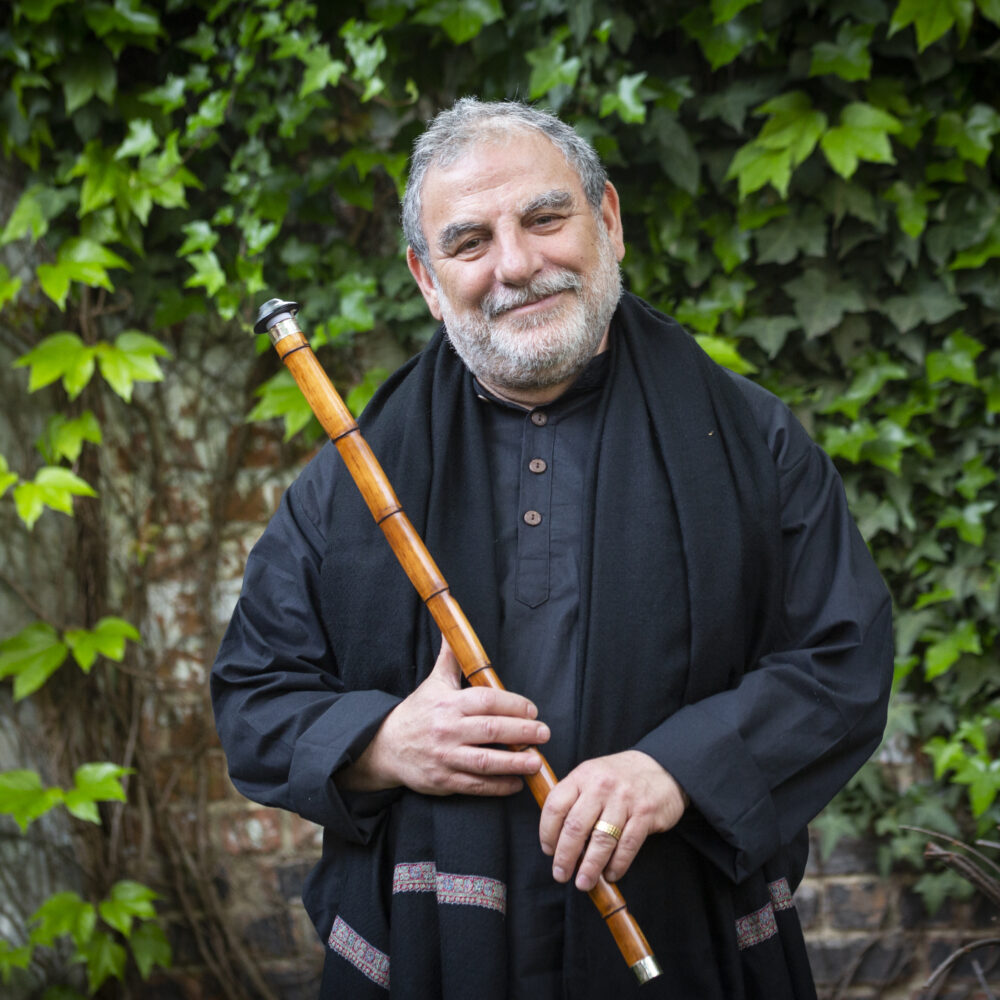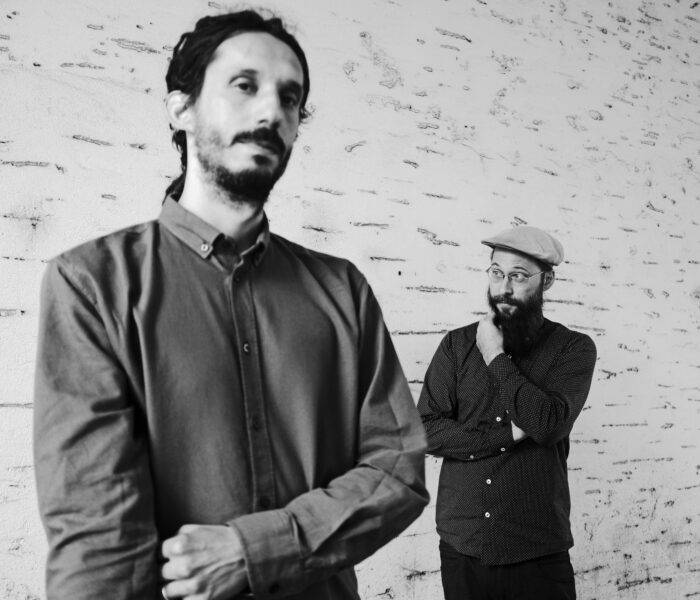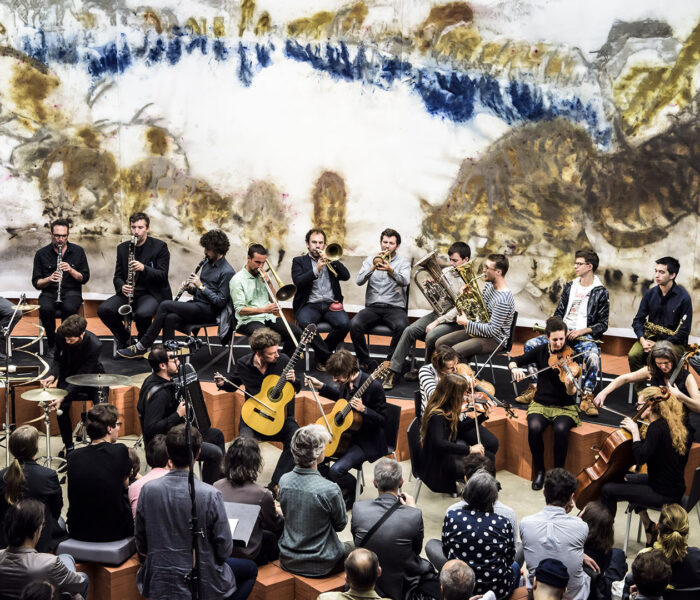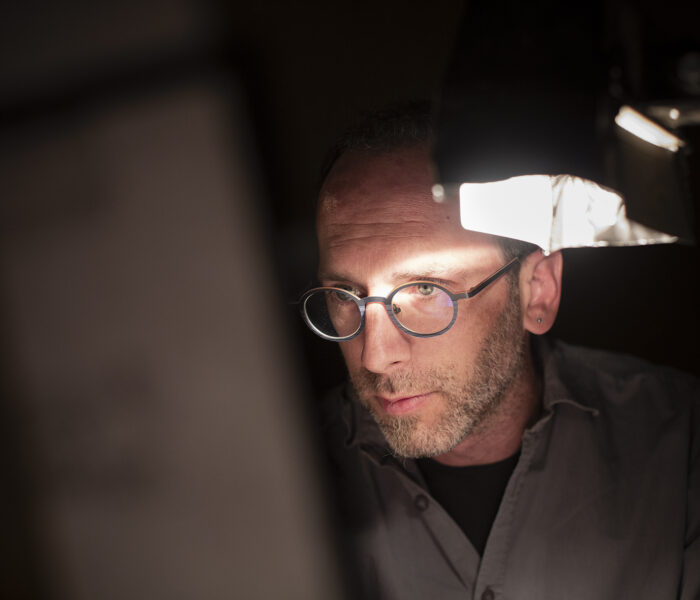A l’occasion d’une rencontre à Paris, Kudsi Erguner, l’un des plus grands interprètes du ney, nous livre ses réflexions sur la transmission, la mémoire, l’écriture et l’improvisation dans la musique savante ottomane depuis ses origines.
Kudsi Erguner est un joueur de ney turc et un savant, dont la famille fait chanter cette flûte en roseau ancestral de père en fils depuis la cour du dernier Sultan. Musicien, compositeur, et professeur à Rotterdam et à Venise, il a collaboré avec Peter Brook, Maurice Béjart, Bartabas, Carolyn Carlson ou encore Georges Aperghis, Marc Minkowski et travaille actuellement avec Robert Wilson.
Le ney est un instrument particulier dans l’histoire de la musique ottomane qui symbolise l’âme du divin. Vous êtes vous-même issu d’une grande lignée de musiciens de tradition soufie. Vous tenez votre savoir de votre père, Ulvi Erguner. Comment s’est passé cet apprentissage de la musique savante ottomane ? Comment se transmet-elle? On parle souvent de transmission orale concernant les musiques extra-européennes…
Tout d’abord, je veux souligner que mon père a créé une école, on peut parler de personnalisation de la tradition, il y a un style Erguner.
Et non, il n’y a pas de tradition orale!
L’ethnologue veut voir la culture musicale non européenne comme une culture qui n’a pas de science et qui se transmet uniquement oralement. Mais ce n’est pas juste. Du Ve au XIe siècle, beaucoup de livres ont été écrits sur la théorie de la musique souvent en lien avec la philosophie grecque. Cela a commencé avec Pythagore et le calcul mathématique d’intervalles spécifiques. Il y a un apport à la fois mathématique et spéculatif. Nous avons aussi des partitions depuis le début du Xe-XIe siècle, ces partitions sont écrites avec des lettres (en alphabet arabe), ABCDEF.
Mais notre relation à la musique écrite n’est pas la même qu’en Europe, où l’on exige une grande précision, surtout à partir du XVIIIe siècle, pour qu’elle puisse être jouée par les orchestres symphoniques. Alors que pour nous, l’écriture est avant tout un aide-mémoire. On mémorise la musique et on ne consulte la partition que pour se rappeler certains passages.
Nous avons donc connu l’écriture byzantine, pour 80-90% du répertoire.
Ensuite, Dimitri Cantemir, prince moldave qui a vécu à Istanbul et a été accueilli par le sultan au palais où il a suivi l’enseignement de la musique, a transcrit plus de 350 œuvres instrumentales des XVIe et XVIIe siècles, selon un système alphabétique de notation personnel, que l’on appelle aujourd’hui l’écriture Cantemir.
Puis est venu Hamparsum Limonciyan, un théoricien et musicien arménien d’Istanbul qui a utilisé l’écriture neumatique* arménienne.
Enfin, au XVIIIe, est apparue une nouvelle notation introduite pas Giuseppe Donizetti (frère de Gaetano), musicien de fanfare dans l’armée italienne qui a résidé lui aussi à la cour du sultan Mahmoud, où il organisait des concerts et accueillait des célébrités comme Franz Liszt.
Au début, cela n’a pas marché. Jusqu’à la génération de mes parents, on utilisait la notation arménienne mais après les années 1940-45, on a commencé à écrire avec des portées.
Comment vous accordez-vous avec les autres musiciens ?
Pour faire simple, dans notre écriture, on ne change pas de clé, donc de hauteur. On décide ensemble dans quelle clé on va jouer et tout le monde sait transcrire immédiatement. C’est toujours un problème quand je joue avec des Européens !
Pouvez-vous nous expliquer ce que sont les maqâms, ces modèles, et ce que sont les taqsims, ces parties improvisées ?
En Orient, nous avons donc ce système qu’on appelle maqâm. Dans ce système modal qui organise les intervalles entre chaque note et qui donne en même temps le sentiment lié à chaque mode, il n’y a pas de hauteur alors qu’en Europe on a fixé le son dans la gamme (tempérée diatonique).
Ce qui est important pour nous, c’est la relation avec les sons.
Dans la musique contemporaine, c’est encore différent. J’ai joué il y a quelques années une pièce de John Cage, avec une flûte japonaise. Cage dessine des graphiques et on est libre de voyager entre les notes. C’était pareil avec Nicolas Frize qui a écrit pour le ney, mais seulement d’une manière graphique. Il y a eu aussi Georges Aperghis. Nous sommes très habiles pour déchiffrer ce genre de partitions graphiques !
Concernant l’improvisation, il y en a deux sortes : l’une rythmée, et l’autre sans rythme. Car il y a d’abord une mémoire remplie de mélodies. Chaque mode a son ethos, son caractère, il faut bien les connaître en les apprenant de mémoire. Il y a environ 490 maqâms, chacun ayant ses intervalles
Les contemporains disent souvent que c’est une gamme, mais ce n’est pas le cas.
Qu’est-ce que cela représente pour vous?
Pour moi, c’est un itinéraire mélodique qui a des intervalles bien spécifiques et intègre une hiérarchie dans ces intervalles.
D’un maqâm à l’autre, l’atmosphère change. C’est le seyir, l’itinéraire.
Dans toute la musique savante, il y a un lien avec la littérature ottomane; il y a des formes qui se succèdent, des cycles rythmiques. Ces formes font une suite, mais la pièce maîtresse d’une suite peut faire 14 ou 15 pages ! Ce n’est pas une chansonnette, c’est long, et donc difficile à mémoriser.
Quelles seraient alors les différences entre la musique ottomane et la musique occidentale ?
Il y a une différence dans la notation elle-même. La gamme tempérée européenne est appelée diatonique car elle a 12 sons.
Chez nous c’est différent, la subtilité perdue avec le tempérament égal, nous l’avons gardée dans la subtilité des intervalles. Nous avons 7 tierces quand vous n’en avez que 2, par exemple. Donc on peut jouer cette musique avec un clavier diatonique, mais c’est moche, on reconnaît la mélodie mais il n’y a pas l’intervalle…
Je vais vous raconter une histoire : en 1932 au Caire, en Égypte, le monde arabe s’est réuni en congrès pour savoir comment faire : comment écrire la musique? On a décidé de diviser par deux la gamme diatonique, et donc on a créé 24 intervalles.
C’était tout aussi catastrophique
Mais cela a été conservé dans le monde arabe, en Egypte, en Syrie et en Irak et même en Afrique du nord. Nous, les Turcs, nous avons conservé les 24 intervalles pour garder cette simplification mais de manière non tempérée.
Que s’est-il donc passé après 1932 en Turquie ?
Ma génération pensait en termes de maqâm mais la génération d’aujourd’hui a changé cela.
Un certain Arel (Hüseyin Sadeddin Arel, ndlr), issu de la génération nationaliste et fasciste de la Turquie, qui venait de la musique occidentale, a conçu, à partir de 1943, un système musical qui est encore le plus utilisé aujourd’hui. Il voulait élaborer une théorie de la musique ottomane mais ce ne fut qu’une terrible simplification.
Socrate – à travers la voix de Platon, dans La République – a dit que si l’on veut voir la transformation d’une société il faut voir la transformation de la musique. Mais Atatürk a fait l’inverse : il a fait changer la musique pour changer la société. Pour créer une société progressiste, une société copiée sur celle des Européens. Alors que les Européens ont suivi une progression siècle par siècle, nous n’avons pas eu cette progression !
Donc à cette époque, on a créé des conservatoires, envoyé les jeunes en Allemagne, et cette génération a haï la musique modale, ce fut une guerre politique.
Une politique de la table rase ?
Je pense que toute politique qui se mêle de la vie culturelle est un désastre
Comment la musique savante ottomane a-t-elle continué à vivre ?
L’héritage ottoman n’était pas national. Il fallait une musique turque pour les Turcs, donc on a fait un saut avant l’Islam. L’idée de la république était de retrouver la culture pré-islamique et de la marier avec la musique occidentale. On a invité Bartók, Moussorgski et d’autres ; on a écrit des oratorios comme celui de Yunus Emre pour orchestre. Mais je crois que c’était une mauvaise direction.
Pendant cette période, la musique modale était interdite. Alors, on recevait dans les maisons – mon grand-père, par exemple, recevait tous les mardis -, ou dans les tekke (établissements soufis, ndlr.) : 200 à 300 personnes se réunissaient le week-end, on passait, on jouait de la musique. D’autres ont créé des associations, des chorales universitaires. En tant que lycéen, je les ai fréquentées, c’est là où j’ai appris à pratiquer.
Dans ce contexte de révolution et contre-révolution, que s’est-il passé en Turquie ?
Vers 1976-77 a été ouvert le premier conservatoire de musique turque. Mais je suis contre cette idée : la musique n’a pas de nationalité, ça doit circuler. À qui appartient la musique turque ?
On voulait incorporer la polyphonie dans l’héritage de la musique ottomane, faire de la musique pour orchestre, mais c’est souvent très kitsch !
On dit que la musique ottomane est monodique mais non, elle est hétérophonique. Tout en jouant la même mélodie, chaque interprétation est différente. Chacun a sa version, elle a des variations et des ornements différents.
Les fascistes ont tout unifié, un unisson absolu. Les chanteurs respirent en même temps, c’est froid, j’étais dégoûté. Je suis un peu réactionnaire (sourire) !
Vous avez poursuivi vos études à Londres et à Paris, en commençant par l’architecture, tout en poursuivant votre carrière de musicien. Comment s’est construit le passage entre les deux cultures ?
Un jour où je devais faire escale à Paris, en 1972, j’ai atterri chez un ami de mon père – mon père avait des amis partout, à Londres, à Paris, qui s’intéressaient à la musique Mevlevi et qui venaient en Turquie pour le rencontrer. Cet ami architecte, Hervé Baley, et un jeune cinéaste, Pierre-Marie Goulet, m’ont accueilli et je suis resté coincé là. J’ai fait des études d’architecture puis de musicologie tout en jouant en concert ou pour la radio. Je rencontrais des musiciens de tous horizons. Quand j’écoute de la musique indienne, arabe, des Balkans, c’est aussi mon univers. Les frontières politiques sont beaucoup plus restreintes que la culture.
Comment travaillez-vous avec des artistes de cultures différentes ?J’ai initié beaucoup de projets mais pas des projets de « fusion » comme on en fait aujourd’hui. Les musiques qui se rencontrent doivent avoir des proximités entre elles. Pour le disque Taj Mahal, j’ai joué avec des Indiens.
J’ai aussi collaboré avec des musiciens flamenco car nous avons des points communs : du VIIe au XVe siècles, l’Andalousie était musulmane. Ce fut un projet passionnant, en lien avec le philosophe Ibn Arabi Sufi, né à Murcia et venu à Konya, dans le sud de la Turquie. Il est mort à Damas en 1240. J’ai trouvé un livre de ses poèmes et j’ai écrit la musique du spectacle L’Orient de l’Occident, que nous avons joué au Festival Grec à Barcelone en 1994.
Et puis j’ai beaucoup composé : pour le Mahabharata de Peter Brook, pour Peter Gabriel, mais aussi Maurice Béjart, Didier Lockwood, Jean-Michel Jarre; j’ai travaillé avec Tony Gatlif, Bartabas (Lever de soleil) ou encore Markus Stockhausen (Gazing Point). Également, avec quelques artistes turcs comme les metteurs en scène de théâtre Mehmet Ulusoy et Genco Erkal, le pianiste Fazil Say.
Mes contemporains ont souvent des préjugés, et pensent que je joue de la musique traditionnelle parce que je joue du ney ; si je jouais du piano, ils diraient que c’est contemporain. C’est l’instrument qui crée l’écoute, on classifie trop.
Je me considère comme un contemporain qui crée des projets qui évoquent la tradition.
Actuellement vous enseignez à CODARTS, l’Université de Performing Arts de Rotterdam et vous avez créé un ensemble Bîrûn, à la Fondazione CINI, à Venise. Comment enseigne-t-on le ney aujourd’hui ? Comment transmet-on ce savoir ?
J’enseigne le ney mais je ne me considère pas comme un professeur de ney : j’enseigne avant tout la musique. Par exemple, à Rotterdam, j’ai une étudiante chinoise qui joue du erhu, un violon à une corde, un autre qui joue de la guitare électrique, un autre du oud… Je leur enseigne non pas la technique du ney, mais le maqâm.
Qui sont ces étudiants ? Et que viennent-ils chercher alors ?
Il y a beaucoup de Grecs, des Syriens, des Français, une jeune Hollandaise qui joue de la harpe.
Je vous raconte une autre histoire : dans les années 1970, j’ai donné un concert à l’église Saint-Merri à Paris. Trois jours après, un jeune homme est venu frapper à ma porte (il n’y avait pas d’autres moyens à l’époque pour joindre les gens !) qui me dit : “Je joue du hautbois et j’enseigne au conservatoire, je suis le 1er hautbois de l’Orchestre de Paris; je vous ai vu jouer tout seul sans partition pendant une heure, mais nous, avec mes camarades, nous ne sommes pas capables de jouer sans partition ! C’est ça que je veux apprendre”. Il cherchait une identité de soliste, une voie de soliste.
Et en effet, beaucoup de ces jeunes sont dans cette recherche de la mémoire. À part les Grecs qui ont déjà cette pratique : on leur a dit qu’ils étaient Européens mais en fait ce sont aussi des Anatoliens et ils viennent vers moi pour retrouver leur histoire.
Il y a des jeunes de toutes les nationalités qui sont intéressés par les maqâms mais parmi eux, très peu de jeunes Turcs. Moi-même, je joue très peu en Turquie.
Vous donnez des concerts dans le monde entier, vous avez été reconnu en 2016, Artiste Unesco pour la paix et le dialogue entre les cultures, qui consacre une carrière dédiée à maintenir vivant le patrimoine musical de votre pays d’origine, la Turquie. Pensez vous à votre propre héritage ?
Il y a tous ces élèves, mes ensembles, l’ensemble Bîrûn, l’ensemble Lâmekân… Voilà mon héritage!
Propos recueillis par Sandrine Maricot Despretz
À écouter sur France Culture, dans Chrétiens d’Orient, “De Byzance à Istanbul, avec Kudsi Erguner”
*neumatique : Signe de notation musicale dans le plain-chant regroupant plusieurs notes sur une seule syllabe, notamment à la finale d’un mot.



)



